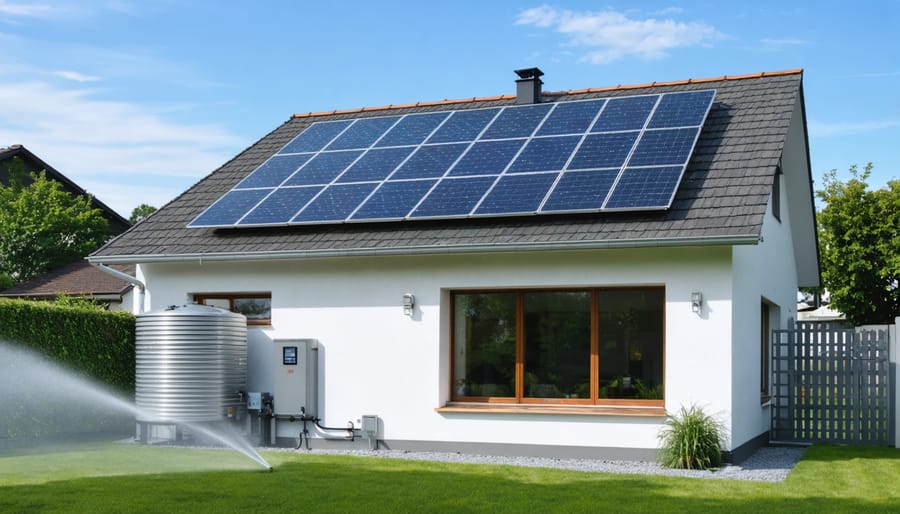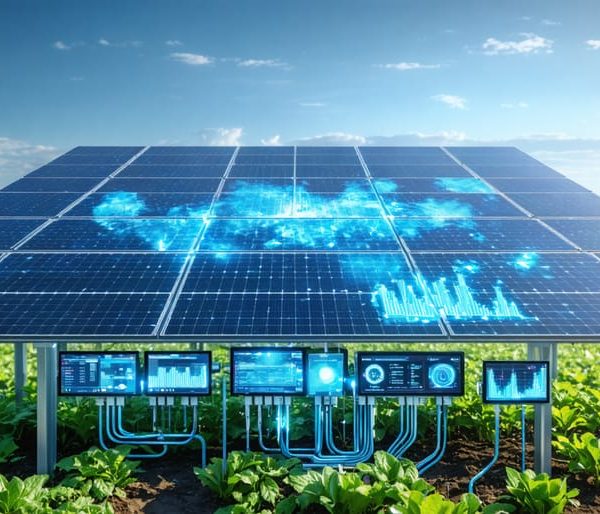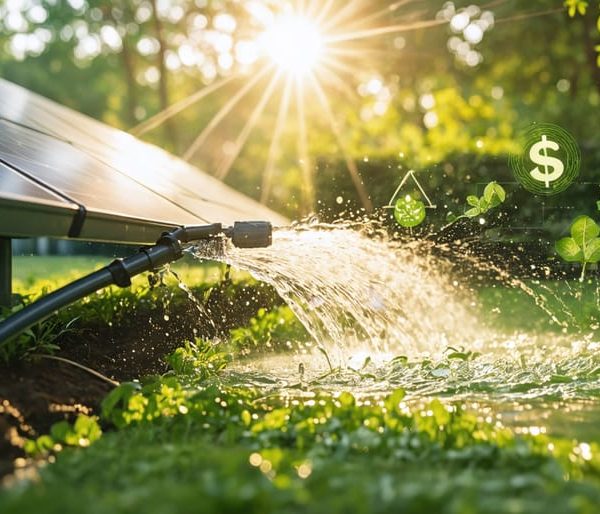Solar-Powered Water Systems That Pay For Themselves (Real Numbers Inside)
Transform your home’s water system into a sustainable powerhouse with solar-powered pumping technology that slashes electricity costs while ensuring a reliable water supply 24/7. This revolutionary approach to water management combines the limitless energy of the sun with smart pumping systems, offering independence from traditional power grids and reducing your carbon footprint.
Solar-powered water systems have evolved from simple irrigation solutions to sophisticated setups capable of meeting all household water needs – from garden sprinklers to household plumbing. By harnessing solar energy to power efficient pumps, these systems can lift water from wells, fill storage tanks, and maintain consistent pressure throughout your property without drawing a single watt from the power grid.
Modern solar water systems deliver impressive results even in cloudy conditions, thanks to advanced photovoltaic technology and efficient energy storage solutions. Whether you’re looking to power a small garden fountain or supply water to an entire household, these systems offer scalable, cost-effective solutions that typically pay for themselves within 3-5 years through reduced utility bills and minimal maintenance requirements.
Join thousands of homeowners who’ve already made the switch to clean, renewable water pumping solutions that work silently, reliably, and sustainably – all while reducing monthly operating costs and environmental impact.
How Solar-Powered Water Systems Actually Work
Core Components You Need
A solar-powered water system relies on several key components working together seamlessly. The heart of the system is the solar panel array, which converts sunlight into electrical energy. These panels should be sized according to your water needs and available sunlight hours. When wiring your solar system, you’ll need to connect it to a solar charge controller, which regulates the voltage and current coming from the panels.
The submersible or surface pump is another crucial component, responsible for moving water from your source to its destination. Choose between DC pumps, which run directly off solar power, or AC pumps paired with an inverter. Speaking of inverters, they’re essential if you’re using AC-powered equipment, converting DC power from the panels into usable AC power.
Don’t forget about water storage solutions like tanks or cisterns, which ensure water availability during cloudy days or nighttime. Lastly, you’ll need monitoring equipment and automatic shut-off devices to protect your system from damage and maintain optimal performance.
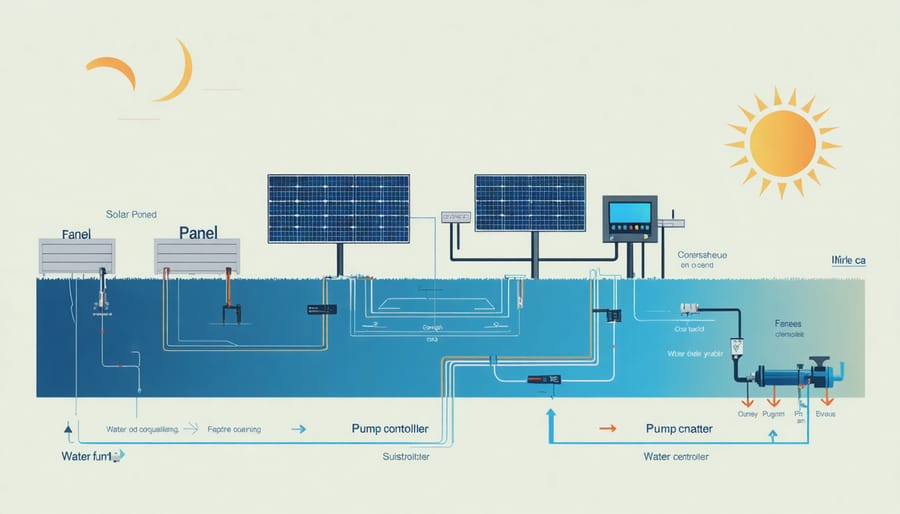
The Water Flow Process
The water flow in a solar-powered water system follows a seamless, energy-efficient path. Starting at the water source, such as a well or storage tank, the process begins when sunlight hits the solar panels, generating electricity to power the pump. This clean energy activates the submersible or surface pump, which draws water from the source.
As the water is pulled up, it passes through a series of filters to remove sediment and impurities. The filtered water then moves into a pressure tank, which maintains consistent water pressure throughout your system. This pressure tank acts as a buffer, ensuring steady water flow even when solar power varies throughout the day.
From the pressure tank, water flows through your distribution pipes to wherever it’s needed – whether that’s your home’s faucets, an irrigation system, or livestock watering stations. Any excess water is stored in an elevated storage tank, using gravity to maintain pressure when solar power isn’t available.
The system includes safety features like check valves to prevent backflow and pressure switches to regulate operation, ensuring efficient water delivery while maximizing solar energy use.
Urban Applications That Make Sense
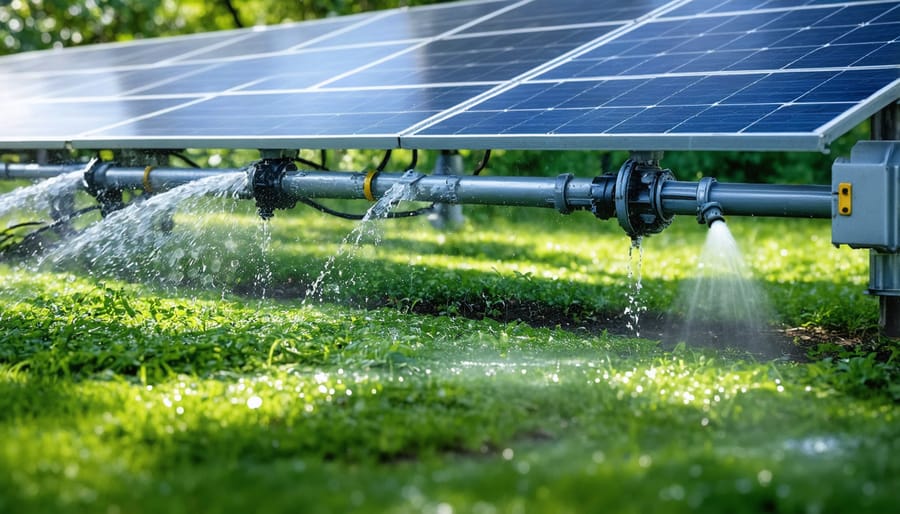
Home Garden Irrigation
Transform your home garden into a self-sustaining oasis with modern solar-powered irrigation systems. These smart solutions combine the power of the sun with efficient water management to keep your plants thriving while reducing both water consumption and utility bills.
A typical home garden irrigation setup includes solar panels, a controller unit, water pump, and strategically placed sprinklers or drip lines. The system automatically waters your plants based on moisture sensors and pre-programmed schedules, ensuring optimal water distribution throughout your garden.
Installation is straightforward: mount the solar panels in a sunny spot, connect the controller and pump, and lay out your irrigation lines. Many homeowners report up to 40% reduction in water usage after switching to solar irrigation, with the added benefit of maintaining healthier plants through consistent watering.
Smart features like rain sensors and zone control allow you to customize watering patterns for different areas of your garden. Vegetables can receive more frequent watering, while drought-resistant plants get just what they need. The system can even adjust watering times based on seasonal changes and weather conditions.
Best of all, these systems work independently of the grid, continuing to nurture your garden even during power outages. With minimal maintenance requirements and a lifespan of 15-20 years, solar irrigation is a sustainable investment in your garden’s future.
Pool Systems and Water Features
Solar-powered systems are revolutionizing how we operate and maintain pools and water features. By harnessing the sun’s energy, these systems can power pool pumps, filtration equipment, and decorative fountains while significantly reducing electricity costs and environmental impact.
For swimming pools, solar-powered pumps can efficiently circulate and filter water during daylight hours, maintaining crystal-clear conditions without drawing from the grid. Many homeowners find that a properly sized solar system can handle their pool’s entire pumping needs during summer months, with some systems even storing excess energy for cloudy days or evening operation.
Decorative water features benefit particularly well from solar power. Whether you’re installing a garden fountain, a small pond aerator, or a cascading waterfall, solar-powered systems offer incredible flexibility in placement since they don’t require proximity to electrical outlets. These systems typically come with built-in batteries, ensuring your water features continue operating even after sunset.
Installation is surprisingly straightforward, with many modern systems offering plug-and-play functionality. The key components include solar panels, a controller, and an efficient DC pump. For optimal performance, position the solar panels where they’ll receive maximum sunlight exposure, typically facing south in the Northern Hemisphere.
Maintenance is minimal, usually requiring only occasional panel cleaning and pump checks. This simplicity, combined with zero operating costs, makes solar-powered water features an attractive option for both residential and commercial properties looking to enhance their outdoor spaces sustainably.
Rural Solutions That Transform Properties
Well Pumping Systems
Solar-powered well pumping systems are revolutionizing water access in remote locations, offering a reliable and sustainable solution where traditional power sources are unavailable or cost-prohibitive. These systems harness solar energy through photovoltaic panels to power submersible or surface pumps, drawing water from underground wells without depending on the electrical grid.
A typical solar well pump system consists of solar panels, a pump controller, and the pump itself. The solar panels convert sunlight into electricity, while the controller manages power flow and protects the pump from damage. Modern systems can pump water to heights of 650 feet or more, making them suitable for various terrain conditions.
What makes these systems particularly appealing is their low maintenance requirements and operational costs. Once installed, they operate automatically during daylight hours, requiring minimal oversight. Many systems now include smart controllers that adjust pumping rates based on available sunlight and water demand, maximizing efficiency.
For remote properties, farms, and off-grid locations, solar well pumps offer distinct advantages. They eliminate the need for fuel delivery, reduce noise pollution, and provide consistent water supply without monthly utility bills. Users report significant cost savings over traditional electric or generator-powered systems within the first few years of operation.
Storage solutions, such as elevated tanks or reservoirs, can be integrated to ensure water availability during cloudy days or nighttime, making these systems reliable year-round water sources for both domestic and agricultural use.
Agricultural Irrigation
Solar-powered water systems have revolutionized agricultural irrigation, offering farmers a sustainable and cost-effective solution for their water management needs. These systems harness solar energy to power pumps that draw water from wells, rivers, or reservoirs, distributing it efficiently across farmland through various irrigation methods.
The setup typically includes solar panels, a controller, and a submersible pump that can deliver thousands of gallons of water per day. Modern systems often incorporate smart technology, allowing farmers to monitor soil moisture levels and automate irrigation schedules based on real-time data.
For large-scale farms, solar irrigation systems can be designed to cover hundreds of acres, with multiple pump stations working in coordination. These systems are particularly valuable in remote locations where grid electricity is unreliable or unavailable. Farmers report significant reductions in operational costs, with many systems paying for themselves within 3-5 years through energy savings.
Success stories include a 200-acre organic farm in California that reduced its monthly energy costs by 70% after switching to solar irrigation. Another example comes from a wheat farmer in Kansas who eliminated $15,000 in annual diesel costs by installing a solar-powered center pivot system.
The scalability of these systems means farmers can start small and expand as needed, making the transition to solar power more manageable. With proper maintenance, these systems can operate reliably for 20-25 years, providing sustainable irrigation solutions for generations of farmers.
Real Cost Analysis and ROI
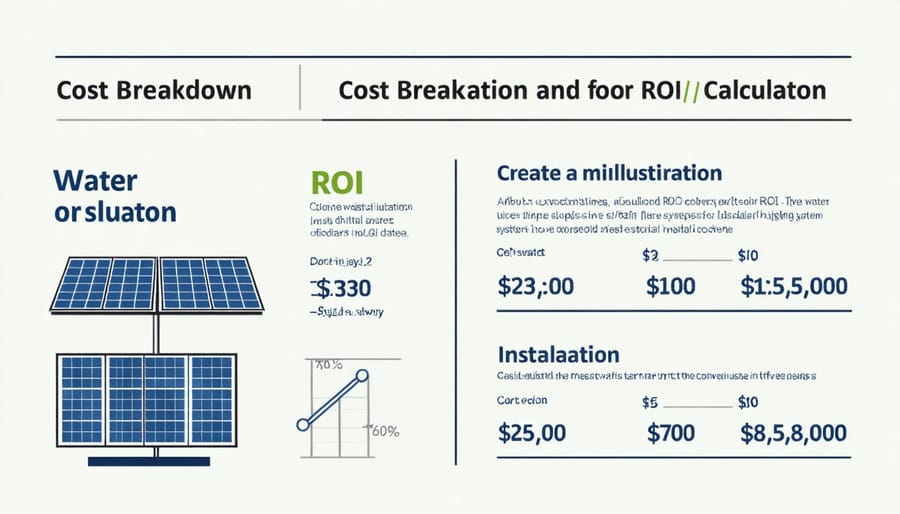
Initial Investment Breakdown
Understanding the initial investment for a solar-powered water system helps you plan your budget effectively. The main components typically include solar panels ($800-1,500), a water pump ($300-800), a controller ($150-300), and storage tanks ($200-1,000), with prices varying based on system size and quality.
Installation costs generally range from $1,000 to $3,000, depending on your location and system complexity. This includes professional labor, mounting hardware, and necessary piping connections. For a complete residential system, expect to invest between $2,450 and $6,600 total.
Here’s a quick breakdown of additional materials you’ll need:
– Wiring and electrical components: $100-200
– Mounting brackets and racks: $200-400
– Piping and fittings: $150-300
– Pressure tank (if required): $200-500
Keep in mind that prices can vary significantly based on your specific needs and location. Many states offer tax incentives and rebates that can reduce your initial investment by 20-30%. While the upfront cost might seem substantial, most homeowners report breaking even within 5-7 years through reduced utility bills and maintenance costs.
For optimal performance and longevity, it’s recommended to work with certified installers who can ensure proper system sizing and installation. They can also help you navigate local building codes and permit requirements.
Long-term Savings Calculator
Calculating your potential savings with a solar-powered water system is easier than you might think. To get started, gather your current monthly water heating bills and follow this simple formula:
Monthly Energy Cost × 12 = Annual Water Heating Expense
Annual Expense × 20 years = Long-term Traditional Cost
Now, let’s factor in solar savings. Solar-powered water systems can help you reduce your energy costs by 50-80%, depending on your location and system efficiency. For example, if you currently spend $100 monthly on water heating:
$100 × 12 = $1,200 yearly
$1,200 × 20 = $24,000 over two decades
With a solar water system saving 65% on average:
$24,000 × 0.65 = $15,600 in total savings
Don’t forget to consider:
– Annual maintenance costs ($100-200)
– System longevity (20-25 years)
– Available tax incentives and rebates
– Rising utility rates (typically 2-5% annually)
– Increased property value
Remember that actual savings vary based on your climate, usage patterns, and local utility rates. Many homeowners find their systems pay for themselves within 5-7 years, making them an excellent long-term investment in both financial and environmental terms.
Installation and Maintenance Tips
Installing a solar-powered water system starts with careful site assessment. Choose a location that receives maximum sunlight throughout the day, typically south-facing in the Northern Hemisphere. Mount your solar panels at a 30-45 degree angle for optimal sun exposure, ensuring they’re elevated enough to avoid shade from nearby structures or vegetation.
Begin by connecting your solar panels to the charge controller, which regulates power flow to your batteries. Install the batteries in a cool, dry, ventilated space to extend their lifespan. Next, connect your water pump to the system, ensuring all electrical connections are properly sealed against moisture.
For ongoing maintenance, clean your solar panels monthly using soft cloths and mild soap to remove dust and debris. Check battery fluid levels quarterly and top up with distilled water if needed. Inspect all connections for corrosion or loose fittings every six months.
Pro tip: Install a monitoring system to track performance and catch potential issues early. Many modern systems come with smartphone apps for easy monitoring.
Common maintenance tasks include:
– Checking and tightening electrical connections
– Lubricating pump components as recommended
– Flushing the water system annually
– Testing backup systems before peak usage seasons
– Trimming vegetation that might shade panels
Remember to keep detailed maintenance records and schedule professional inspections annually. This helps ensure your system operates efficiently for years to come.
Solar-powered water systems represent a bright future for sustainable living and resource management. By harnessing the sun’s energy to power our water needs, we can significantly reduce both our environmental impact and utility costs. These systems offer reliable performance, minimal maintenance requirements, and the satisfaction of energy independence. Whether you’re a homeowner looking to reduce your carbon footprint or a business owner aiming to cut operational costs, solar-powered water systems provide a practical and eco-friendly solution. The time to embrace this technology is now – with increasing affordability, improved efficiency, and various incentives available, making the switch to solar-powered water systems has never been more attractive. Take the first step toward sustainable water management today and join the growing community of environmentally conscious individuals making a positive impact on our planet.

